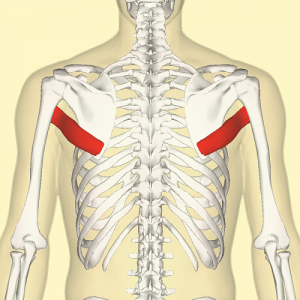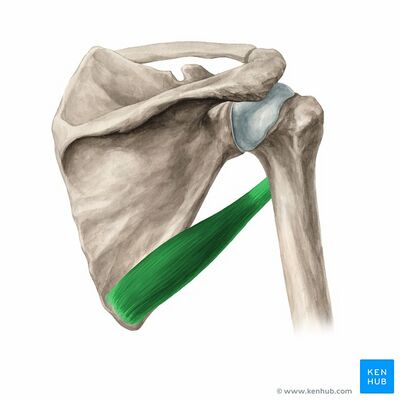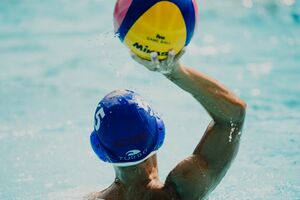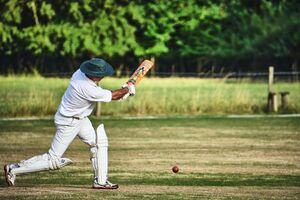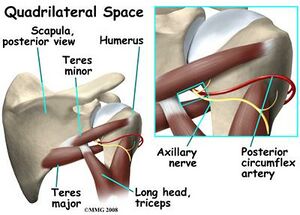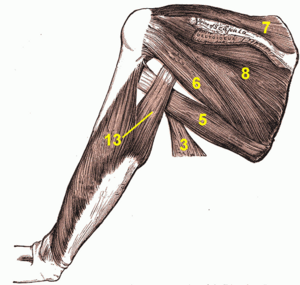Teres Major
Original Editor - Evan Thomas
Top Contributors - Evan Thomas, Lucinda hampton, Joao Costa, Kim Jackson, WikiSysop, 127.0.0.1, Admin, Oyemi Sillo and Naomi O'Reilly
Introduction[edit | edit source]
Teres major (TM) is a small muscle that runs along the lateral border of the scapula. It is one of the seven scapulohumeral muscles that act around the glenohumeral joint to facilitate shoulder movement[1].[2] It's sometimes called "lat's little helper" because of its synergistic action with the latissimus dorsi.[3]
Image 1: Red shows TM
Anatomy[edit | edit source]
Origin: The dorsal surface of the inferior angle of the scapula
Insertion: The medial lip of the intertubercular groove of the humerus[1].
- It is related to the latissimus dorsi muscle which wraps around the lower border of teres major. The tendon of the teres major lies posterior to the tendon of the latissimus dorsi and there is a bursa between them.
Innervation: lower subscapular nerve (C5, C6)
Arterial supply: thoracodorsal branch of the subscapular artery, posterior circumflex humeral artery
Image 2: Teres major muscle (highlighted in green) - posterior view[4]
Function[edit | edit source]
The TM muscle acts as a function as a unit with the latissimus dorsi (LD), where it acts in synergy to extend, adduct and internally rotate the shoulder. eg The TM and LD muscles act in the acceleration and follow through phases of the throwing motion in pitchering in baseball.[5]; assists the latissimus dorsi in eg rock climbing, tennis, wood-chopping, swimming, rowing.[6][7][1]
Image 3: Teres major and latissimus dorsi muscles act in the acceleration and follow through phases of the throwing motion in pitchering in baseball.
Physiotherapy[edit | edit source]
Etiology - Injuries
Stretch or impact injuries to the teres major muscle, sustained while playing sports or in motor vehicle accidents, as well as falls onto the lateral scapula are implicated in the evolution of teres major injuries.
In addition, repeated microtrauma secondary to reaching up and behind (eg retrieving a briefcase from the backseat of a car, overhead throwing, and other sports injuries) may result in the development of myofascial pain in the teres major muscle.
Teres Major injuries result in pain and difficulty with activities that require sideways or backwards movements with the arm.
- Isolated tears of the teres major are quite uncommon, but may occur in baseball or cricket players, especially pitchers and bowlers[8].
- The main symptom of a teres major tear is a sudden sharp pain in the shoulder, upper arm and armpit. This usually arises if the muscle is not given rest and no treatment is carried out.
- The pain is usually dull and intensifies with physical activity and hand behind back activities eg reaching in back pocket, downward stoke of freestyle, pitching in baseball, during tennis.
- Due to inflammation in the affected muscle region swelling may occur. The swelling is not externally visible but can be felt on touching the area (near the bottom of the scapula).[7]
- Discomfort and pain in upper arm reduces the range of motion of the arm in sufferers.
- A jump sign – involuntary withdrawal of the stimulated muscle – is also a common symptom.
- Teres Major Strain often occurs when proper warm up is not done before workouts[9].
- The teres major is overactive and short in people with upper crossed syndrome (UCS), see link.
The teres major is one of four rotator cuff muscles that is involved in many shoulder pathologies, including quadrangular space syndrome[10].
Images 4 & 5: Sports associated with TM injury.
Image 6: Reaching in back pocket elicits pain in TM injury
Image 7: Diagram of the quadrilateral space
Palpation[edit | edit source]
- With the patient in prone and arm off the side of the table, grasp latissimus dorsi between your fingers and thumb
- Move your fingers and thumb medially to the lateral boarder of the scapula
- Teres major muscle fibers lie medial to the latissimus and attach to the lateral boarder of the scapula
- Follow these fibers up towards the axilla where they blend with latissimus dorsi[3]
Image 8: Posterior aspect shoulder - 5 teres major; 3 latissimus dorsi; 6 teres minor; 7 supraspinatus; 8 infraspinatus; 13 triceps brachii long head.
Length Tension Testing / Stretching[edit | edit source]
- With the patient in supine, flex the patient's shoulder to 180 deg with one hand by holding on the forearm
- Stabilize the scapula along the lateral boarder with the other hand
- With the hand holding the forearm, externally rotate the arm
- Both the moving hand and the hand stabilizing the scapula are used to sense the amount of muscle tension and barrier[11]
Treatment[edit | edit source]
Most cases of Teres Major Injury heal successfully without surgery. Treatment includes
- POLICE principle
- Warm up: Teres Major injuries resulting from workouts are usually cured with proper warm-up before exercising. Warm up helps loosen the muscles and tissues and makes them less compact. Flexibility of the muscles helps them stretch and operate more easily.
- Strengthening exercises: work on shoulder stability, compound and isolated teres major exercises eg Seated row with resistance band, Lat pulldown, Chin up, Start at appropriate level, causing no pain. If overhead range of motion is limited, avoid vertical push exercises like the overhead press. Do high-incline push exercises instead (e.g. shoulder press on 60-75° incline)
- Stretches eg Side reach lat stretch; Kneeling lat stretch (arms on floor or arms elevated); Overhead lat stretch.
- Posture: Avoidance of slouching over and internally rotating your shoulders. When sitting down for long periods, get up for a quick break at least every half hour to split up the time spent in that posture. Walk around or stretch out your teres major.
- Trigger Point Realease: TrPs in teres major muscle typically refer pain into the posterior deltoid region and over the long head of the triceps brachii, as well as into the posterior shoulder joint, occasionally into the dorsal aspect of the forearm, and rarely into the scapula or elbow.[6]
- Myofascial Release Techniques
Resources[edit | edit source]
This 2 minute video is a good summary of the Teres Major muscle.[12]
References[edit | edit source]
- ↑ 1.0 1.1 1.2 Radiopedia Teres Major Available: https://radiopaedia.org/articles/teres-major-muscle(accessed 13.1.2022)
- ↑ http://www.gustrength.com/muscles:teres-major-location-actions-and-trigger-points
- ↑ 3.0 3.1 Biel A (2005). Trail Guide to the Body (2nd ed). Boulder, CO: Books of Discovery.
- ↑ Teres major muscle (highlighted in green) - posterior view image - © Kenhub https://www.kenhub.com/en/library/anatomy/teres-major-muscle
- ↑ Fitzpatrick D, Cagle P, Flatow E. Isolated Teres Major Rupture: A case report with a suggested dedicated imaging protocol and review of the literature. Journal of radiology case reports. 2016 Apr;10(4):31. Available: https://www.ncbi.nlm.nih.gov/pmc/articles/PMC4861626/(accessed 13.1.2022)
- ↑ 6.0 6.1 Travell JG, Simons DG, Simons LS (1998). Travell and Simons' Myofascial Pain and Dysfunction: The Trigger Point Manual, Volume 2: The Upper Half of Body (2nd ed). Baltimore, MD: Williams & Wilkins.
- ↑ 7.0 7.1 Ehealth star Teres Major Muscle Available:https://www.ehealthstar.com/anatomy/teres-major-muscle (accessed 13.1.2022)
- ↑ Rehab my patient Teres Major Available:https://www.rehabmypatient.com/shoulder/teres-major (accessed
- ↑ Prime health channel Teres Major Available:https://www.primehealthchannel.com/teres-major.html (accessed 13.1.2022)
- ↑ Dalagiannis N, Tranovich M, Ebraheim N. Teres minor and quadrilateral space syndrome: a review. Journal of orthopaedics. 2020 Jul 1;20:144-6.Available: https://pubmed.ncbi.nlm.nih.gov/32025138/(accessed 13.1.2022)
- ↑ Sanzo P, MacHutchon M (2015). Length Tension Testing Book 2, Upper Quadrant: A Workbook of Manual Therapy Techniques (2nd ed). Canada: Brush Education.
- ↑ Teres major muscle video - © Kenhub https://www.kenhub.com/en/library/anatomy/teres-major-muscle
